
One of the first things you notice when visiting Seattle is "The Mountain"; at first you feel funny calling Mt. Rainier "The Mountain", but then you notice that no matter where you travel in the greater Seattle area when The Mountain is out (free from cloud cover) its visible from everywhere. Rainier Avenue in Seattle is aptly named as it appears as if your going to drive straight down the road and onto The Mountain. From downtown, from Lake Washington, from Lake Sammamish, from every mountain trail you ever hike, Rainier looms above them all. Almost as soon as I began traipsing around the hills I looked longingly at the white slopes of Rainier and thought of climbing it. As you get a bit more experience with the area and learn a bit more about Rainier there are two slightly contradictory discussions that emerge. First there are a lot of people in the greater Seattle area that have either attempted or climbed Rainier, its powerful presence works its magic on many people. Within this group you get a lot of stories about how easy climbing Rainier is, "Yeah my brother and his friends climbed it last year and they said it was just like a really long hike". I suspect many of these are doing the standard route from the Muir side with guides. The second side of the discussion is that Rainier is big, long, hard and dangerous, not to be tackled by the naive or unprepared, guide or not. I think much of the recounting depends on weather, and that regardless I favor the harder rather than the easier categorization.
I've planned at least twice to climb Rainier and I'm glad that I waited until the second to make a go as I was able to be much more experienced than otherwise. My first baby steps into mountaineering came with a purchase of an ice ax and some self arrests up on Guye Peak near Alpental. My first real mountaineering experience was climbing Mt. Olympus with Summit for Someone in 2007, this gave me a lot of the basic mountaineering gear : ice ax, crampons, harness, climbing helmet etc. Additionally since it was a guided trip I was able to grow my experience with the cushion of mules to carry my gear the first 15 miles and the wisdom of the guides. (Craig had climbed Rainier 355 times and Olympus 26). I loved the experience of High Camp, climbing in the dark, experiencing the joy of sunrise from on high and the accomplishment of the summit. This year I set my sights on Rainier. I planned to go without a guide, with two friends who had been with me on almost every step of my mountaineering journey : Seth Neilson and Dean Matthews.
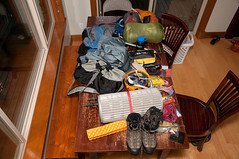 I had a very very busy couple of weeks leading up to Rainier. It began with the 4th of July celebration. I ended up cooking up 15 racks of ribs for myself and members of our local congregation (my own choosing), then it was a frantic couple of days packing and getting ready for Trek : Mormon pioneer handcart reenactment. I'd been asked to go as the main photographer. Trek went from Wednesday July 8th through Saturday July 11th, over the course of those 4 days and the 21 miles we traveled I took over 4000 photos and many gigs of video. Immediately after Trek ended I drove to Ellensburg with my two daughters and some of their friends to shower at a truck stop and then we drove out to The Gorge to watch Coldplay preform. We got home around 1:30 am and I ended up going to bed at 2:30. Then Sunday was all day at church and immediately upon getting home I started editing the 4000 photos. I was to leave for Rainier Wednesday night and had to have a slideshow of 400 with music ready by Tuesday. I ended up staying up all night Monday working on the video, grabbed a few hours of sleep from 5:30 am to 9:30 am and then stumbled into work. After work on Tuesday I kept going on the video and finally delivered a working DVD to the audio visual guy in charge. Finally some sleep, go to work Wednesday, and then a BBQ with Dean and Seth's family Wednesday evening. Wednesday at 9pm, Seth and Dean and myself loaded up the car and we made one last stop at REI and headed for the White River campground in Rainier National Park.
I had a very very busy couple of weeks leading up to Rainier. It began with the 4th of July celebration. I ended up cooking up 15 racks of ribs for myself and members of our local congregation (my own choosing), then it was a frantic couple of days packing and getting ready for Trek : Mormon pioneer handcart reenactment. I'd been asked to go as the main photographer. Trek went from Wednesday July 8th through Saturday July 11th, over the course of those 4 days and the 21 miles we traveled I took over 4000 photos and many gigs of video. Immediately after Trek ended I drove to Ellensburg with my two daughters and some of their friends to shower at a truck stop and then we drove out to The Gorge to watch Coldplay preform. We got home around 1:30 am and I ended up going to bed at 2:30. Then Sunday was all day at church and immediately upon getting home I started editing the 4000 photos. I was to leave for Rainier Wednesday night and had to have a slideshow of 400 with music ready by Tuesday. I ended up staying up all night Monday working on the video, grabbed a few hours of sleep from 5:30 am to 9:30 am and then stumbled into work. After work on Tuesday I kept going on the video and finally delivered a working DVD to the audio visual guy in charge. Finally some sleep, go to work Wednesday, and then a BBQ with Dean and Seth's family Wednesday evening. Wednesday at 9pm, Seth and Dean and myself loaded up the car and we made one last stop at REI and headed for the White River campground in Rainier National Park. We arrived around 11pm, found an open campsite and threw down our pads and jumped in our bags. Thankfully there were no mosquitoes around. We were right by a creek, and the noise quickly had us all sleeping, finally after a busy busy two weeks I could relax. The next morning we woke around 6 am and made our way down to the ranger station at the Sunrise entrance to wait in line for climbing passes and camping permits. We didn't have reservations and they reserve 12 spots for a first come first serve basis. There were three options to camp at : Camp Curtis, which sits on a rocky ridge atop the Inter Glacier around 9000 feet, Camp Schurman which has a bathroom (!!!!) around 9460 feet and Emmons Flats which sits above Camp Schurman around 9600 feet but like Curtis has no bathroom. By 7:15 when the ranger showed up to tell us she'd be helping us in a few minutes, there were 25 people waiting in line. We were able to get a reservation for Camp Schurman and we quickly drove back up to the White River Campground where we put on our bags and posed for that "before the trip group photo". By 8:25 am we were on the trail.
We arrived around 11pm, found an open campsite and threw down our pads and jumped in our bags. Thankfully there were no mosquitoes around. We were right by a creek, and the noise quickly had us all sleeping, finally after a busy busy two weeks I could relax. The next morning we woke around 6 am and made our way down to the ranger station at the Sunrise entrance to wait in line for climbing passes and camping permits. We didn't have reservations and they reserve 12 spots for a first come first serve basis. There were three options to camp at : Camp Curtis, which sits on a rocky ridge atop the Inter Glacier around 9000 feet, Camp Schurman which has a bathroom (!!!!) around 9460 feet and Emmons Flats which sits above Camp Schurman around 9600 feet but like Curtis has no bathroom. By 7:15 when the ranger showed up to tell us she'd be helping us in a few minutes, there were 25 people waiting in line. We were able to get a reservation for Camp Schurman and we quickly drove back up to the White River Campground where we put on our bags and posed for that "before the trip group photo". By 8:25 am we were on the trail.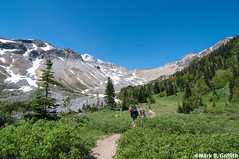 The trail up from White River was destroyed the last couple of winter and spring seasons by rain, much of the trail that used to wander along the high bank has been washed out and the trail meanders threw strewn rock fields of gravel, boulders and logs. In three miles the maintained trail ends at Glacier Basin, a gorgeous valley with a large meadow full of wild flowers and a small pond. A boot path leads from here up the valley along the river on the high ridge of the lateral moraine of an ancient glacier that has long rescinded. The trail along the moraine was covered in wild flowers, lupine and paintbrush of every hue of red. The smell of the flowers was palpable and it was like walking through the mostly beautifully planned garden estate. At the top of the moraine and the back of the valley, you reach the toe of the Inter Glacier which winds left or westerly up the slopes of Rainier. We stopped and took a break for about an hour, refilling our water and grabbing a bite to eat. My peanut butter and honey sandwich from the night before tasted heavenly. The 3000 foot Inter Glacier has fewer crevasses than the Emmons, and they open much later in the season. We made the decision to not rope up, though we put on harnesses and got out our ice axes.
The trail up from White River was destroyed the last couple of winter and spring seasons by rain, much of the trail that used to wander along the high bank has been washed out and the trail meanders threw strewn rock fields of gravel, boulders and logs. In three miles the maintained trail ends at Glacier Basin, a gorgeous valley with a large meadow full of wild flowers and a small pond. A boot path leads from here up the valley along the river on the high ridge of the lateral moraine of an ancient glacier that has long rescinded. The trail along the moraine was covered in wild flowers, lupine and paintbrush of every hue of red. The smell of the flowers was palpable and it was like walking through the mostly beautifully planned garden estate. At the top of the moraine and the back of the valley, you reach the toe of the Inter Glacier which winds left or westerly up the slopes of Rainier. We stopped and took a break for about an hour, refilling our water and grabbing a bite to eat. My peanut butter and honey sandwich from the night before tasted heavenly. The 3000 foot Inter Glacier has fewer crevasses than the Emmons, and they open much later in the season. We made the decision to not rope up, though we put on harnesses and got out our ice axes.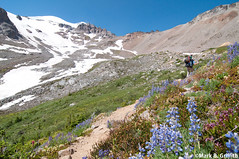 The snow was soft from the summer heat but not so slushy you were wallowing in it. I think there are three important keys ascended those 3000 feet. First is pacing. Mountaineering should not be a race, its a marathon. You'll be spending a long time going up, its important to not break into a sweat or over-exert yourself, using the rest step is a great way to enforce this and conserve energy. The rest step is done as you raise your foot and plant, you lock that leg with the knee back, then step up with the other foot, which you plant, lock and repeat. Thus each step has a small rest built in, even if you do this fast it allows your legs to last longer. When your more tired or feeling the effects of altitude the rests become longer and they allow an easy pause without having to burn energy holding you legs actively against the slope. Second hydration. Drink lots and lots of water. Frankly I've never pee'd so much in my life and yet despite that there was no yellow snow : all was clear. Finally : I-pod. When the danger is low (i.e. no crevasse or rock fall) and communication with your climbing mates is not critical, music helps to lift your spirits and motivate you along the way.
The snow was soft from the summer heat but not so slushy you were wallowing in it. I think there are three important keys ascended those 3000 feet. First is pacing. Mountaineering should not be a race, its a marathon. You'll be spending a long time going up, its important to not break into a sweat or over-exert yourself, using the rest step is a great way to enforce this and conserve energy. The rest step is done as you raise your foot and plant, you lock that leg with the knee back, then step up with the other foot, which you plant, lock and repeat. Thus each step has a small rest built in, even if you do this fast it allows your legs to last longer. When your more tired or feeling the effects of altitude the rests become longer and they allow an easy pause without having to burn energy holding you legs actively against the slope. Second hydration. Drink lots and lots of water. Frankly I've never pee'd so much in my life and yet despite that there was no yellow snow : all was clear. Finally : I-pod. When the danger is low (i.e. no crevasse or rock fall) and communication with your climbing mates is not critical, music helps to lift your spirits and motivate you along the way.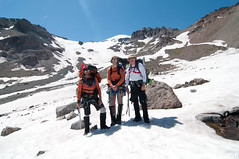 Step, plant, rest. Step, plan, rest. Thousands of steps later we came to the rocky ridge part way up the slope where Camp Curtis sits. There are two approaches to Camp Schurman, the first is to cross the lower ridge through Camp Curtis and then drop down onto the Emmons Glacier and up to Camp Schurman. The second is to continue up the Inter Glacier to the higher ridge and climb up and over Steamboat Prow and drop to Camp Schurman. I highly recommend the first heading over Camp Curtis. First because you don't have to keep climbing up and up the Inter Glacier, second Steamboat Prow is a choss heap of loose rock, the "trail" is steep and with heavy packs heading down would be challenging.
Step, plant, rest. Step, plan, rest. Thousands of steps later we came to the rocky ridge part way up the slope where Camp Curtis sits. There are two approaches to Camp Schurman, the first is to cross the lower ridge through Camp Curtis and then drop down onto the Emmons Glacier and up to Camp Schurman. The second is to continue up the Inter Glacier to the higher ridge and climb up and over Steamboat Prow and drop to Camp Schurman. I highly recommend the first heading over Camp Curtis. First because you don't have to keep climbing up and up the Inter Glacier, second Steamboat Prow is a choss heap of loose rock, the "trail" is steep and with heavy packs heading down would be challenging.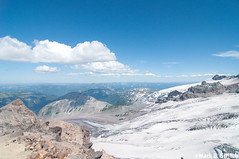 At Camp Curtis we roped up, clipped into our harnesses and put on our helmets, Dean lead out across the rocky slope, which steeply makes its way to where you can drop off the rock onto the Emmons Glacier. The Emmons is much broader and wider than the Inter Glacier and has many more crevasses. The ascent up the glacier is not too long or too steep before Steamboat Prow comes into view and the ridge below it where the Rangers Hut and Camp Schurman sits. There are several large crevasses just outside the camp that you make your way over before getting safely onto the rock. We arrived at 5pm and there were around a dozen tents set up amid the rocks, we chose a nice spot in the middle and setup Seth's 3-man, 4 season tent.
At Camp Curtis we roped up, clipped into our harnesses and put on our helmets, Dean lead out across the rocky slope, which steeply makes its way to where you can drop off the rock onto the Emmons Glacier. The Emmons is much broader and wider than the Inter Glacier and has many more crevasses. The ascent up the glacier is not too long or too steep before Steamboat Prow comes into view and the ridge below it where the Rangers Hut and Camp Schurman sits. There are several large crevasses just outside the camp that you make your way over before getting safely onto the rock. We arrived at 5pm and there were around a dozen tents set up amid the rocks, we chose a nice spot in the middle and setup Seth's 3-man, 4 season tent. 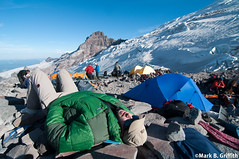 The ranger wandered over to tell us about the bathroom (the very best and worst [stinks to high heaven] feature of the camp), blue bag drops and pointed out a nice seep under one of the crevasses where we could collect water. We got dinner brewing, my Mountainhouse Beef Stroganoff tasted wonderful as did the Tim's Cascde Salt and Vinegar chips.
The ranger wandered over to tell us about the bathroom (the very best and worst [stinks to high heaven] feature of the camp), blue bag drops and pointed out a nice seep under one of the crevasses where we could collect water. We got dinner brewing, my Mountainhouse Beef Stroganoff tasted wonderful as did the Tim's Cascde Salt and Vinegar chips.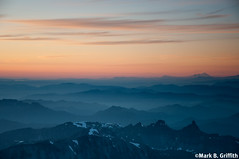 We sat around in the evening chatting with fellow folks in the camp and watched an amazing sunset unfold beyond the Curtis Ridge and the hills north beyond Steamboat Prow. A fire in the area added some amazing depth the layer and layer of mountains were well defined all the way to Mt. Baker on the horizon. While Seth and I were busy snapping away Dean tired to lay down in the tent and relax. As the light faded, the sunlit hit the right angle and the entire Puget Sound and Lake Washington light up with sunset glow. As the light faded even further you could even see the lights on the Tacoma Docks blinking off in the distance. As we turned in I set my alarm early for the next day, in hopes of catching some alpenglow the next morning.
We sat around in the evening chatting with fellow folks in the camp and watched an amazing sunset unfold beyond the Curtis Ridge and the hills north beyond Steamboat Prow. A fire in the area added some amazing depth the layer and layer of mountains were well defined all the way to Mt. Baker on the horizon. While Seth and I were busy snapping away Dean tired to lay down in the tent and relax. As the light faded, the sunlit hit the right angle and the entire Puget Sound and Lake Washington light up with sunset glow. As the light faded even further you could even see the lights on the Tacoma Docks blinking off in the distance. As we turned in I set my alarm early for the next day, in hopes of catching some alpenglow the next morning.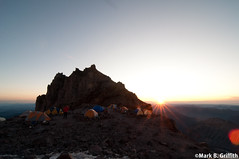 My alarm was supposed to go off at 4:30, I woke at 5:15 of my own accord. By then, any pink alpenglow (if there ever was any) was all gone, and it was just the silhouette of Steamboat against the dark sky and waiting for the sun to crack the horizon. No one else was awake and I carefully tip toed through the rocks with my crocs on, trying to not make any noise. Climbers the night before departing in the dark had been loud and noisy, its kind of hard to walk quietly across rocks in your crampons. I walked up on the snow a little bit and watched the sun peek above the line and the camp and mountain were bathed in that warm early morning light. I headed back to camp and relaxed for a while in the tent reading and catching a few shut eye. We woke as the rest of camp stirred and boiled some water for a breakfast of oatmeal and hot chocolate.
My alarm was supposed to go off at 4:30, I woke at 5:15 of my own accord. By then, any pink alpenglow (if there ever was any) was all gone, and it was just the silhouette of Steamboat against the dark sky and waiting for the sun to crack the horizon. No one else was awake and I carefully tip toed through the rocks with my crocs on, trying to not make any noise. Climbers the night before departing in the dark had been loud and noisy, its kind of hard to walk quietly across rocks in your crampons. I walked up on the snow a little bit and watched the sun peek above the line and the camp and mountain were bathed in that warm early morning light. I headed back to camp and relaxed for a while in the tent reading and catching a few shut eye. We woke as the rest of camp stirred and boiled some water for a breakfast of oatmeal and hot chocolate. 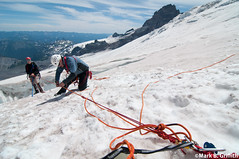 We had no real plans other than to acclimate, rest and recuperate. Dean brought a mini-deck of cards and we sat around on the helipad on our cushions playing a long game of spades. Dean won by a narrow margin with Seth loosing soundly. Around 11 we put on a shell, our harnesses and roped up and headed out on the Emmons to practice crevasse rescue. We ran through the process if someone falls into a crevasse (typically this is the lead individual, but not necessarily) : The other two memebers of the team go into self arrest, lying flat on the snow with their ice axes dug in. Once the furthermost team member has verified that the other team member can hold the weight, s/he gets off his ice ax and using two pickets (long metal devices) sets and anchor. Then s/he attaches a prussik (rope with a special knot around the rope that allows the rope to slide through but under tensions holds fast) and applies the weight to the anchors. A secondary prussik is set and then two pulleys are applied. At this point the nearer individual who's been holding the position in self arrest, clips into the anchor and manages the prussik, the other individual begins (assuming the "victim" in the crevasse can't get themselves out) pulling on the rope to raise the fallen climber.
We had no real plans other than to acclimate, rest and recuperate. Dean brought a mini-deck of cards and we sat around on the helipad on our cushions playing a long game of spades. Dean won by a narrow margin with Seth loosing soundly. Around 11 we put on a shell, our harnesses and roped up and headed out on the Emmons to practice crevasse rescue. We ran through the process if someone falls into a crevasse (typically this is the lead individual, but not necessarily) : The other two memebers of the team go into self arrest, lying flat on the snow with their ice axes dug in. Once the furthermost team member has verified that the other team member can hold the weight, s/he gets off his ice ax and using two pickets (long metal devices) sets and anchor. Then s/he attaches a prussik (rope with a special knot around the rope that allows the rope to slide through but under tensions holds fast) and applies the weight to the anchors. A secondary prussik is set and then two pulleys are applied. At this point the nearer individual who's been holding the position in self arrest, clips into the anchor and manages the prussik, the other individual begins (assuming the "victim" in the crevasse can't get themselves out) pulling on the rope to raise the fallen climber.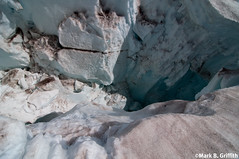 After the pulley rescue practice we all clipped in and were on belay and scooted out to the edge of the crevasse to peer down into the maw and take a few pictures. Afterward we made our way back up to camp and prepared for climbing that evening. We got our summit packs all put together, the harness, crampons and ice axes all laid out for the early morning start. We cooked some dinner and forced a bunch of food and water down. By 6pm we were in our tents and trying to get some sleep. I pulled out my i-pod and put the Jon Hopkins Light Through The Veins song on repeat. The music helped drone out the background noise of the camp as they fixed dinner and we got some shut eye. Its 9 minutes and 18 second long and I listened to it over and over; sometimes with some semblance of consciousness but mostly dead to the world.
After the pulley rescue practice we all clipped in and were on belay and scooted out to the edge of the crevasse to peer down into the maw and take a few pictures. Afterward we made our way back up to camp and prepared for climbing that evening. We got our summit packs all put together, the harness, crampons and ice axes all laid out for the early morning start. We cooked some dinner and forced a bunch of food and water down. By 6pm we were in our tents and trying to get some sleep. I pulled out my i-pod and put the Jon Hopkins Light Through The Veins song on repeat. The music helped drone out the background noise of the camp as they fixed dinner and we got some shut eye. Its 9 minutes and 18 second long and I listened to it over and over; sometimes with some semblance of consciousness but mostly dead to the world. 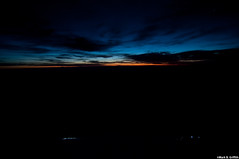 The original plan was to wake at 11:45 and be up and gone by 12:30. Seth set his alarm, but because of his Wyoming timezone we woke at 10:45 pm. We decided rather than try to lay back down we'd just take it easy getting ready and leave when we were ready. We boiled some hot water for oatmeal and hot chocolate. By midnight we were dressed in layers for the journey and in our crampons, harnesses and roped up and heading up towards Emmons Flats and the summit beyond.
The original plan was to wake at 11:45 and be up and gone by 12:30. Seth set his alarm, but because of his Wyoming timezone we woke at 10:45 pm. We decided rather than try to lay back down we'd just take it easy getting ready and leave when we were ready. We boiled some hot water for oatmeal and hot chocolate. By midnight we were dressed in layers for the journey and in our crampons, harnesses and roped up and heading up towards Emmons Flats and the summit beyond.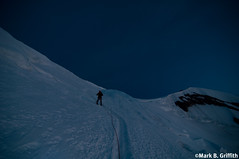 Climbing in the dark is necessary as the snow is hard, the surface features firm and safe. There are other advantages as well : you can't see how much further you have to go. You enter into a zone of silence where all you focus on is the cone of light ahead of you and the partner on the rope above you. Al you can see the next footstep as you plod your way, seemingly eternally, up and up and up. On this journey an i-pod is not available, all your sense must be tuned to the rope ahead, your climbing partner above you and any communication of any sort. This climbing can require a great deal of mental fortitude to keep pushing upwards on and on.
Climbing in the dark is necessary as the snow is hard, the surface features firm and safe. There are other advantages as well : you can't see how much further you have to go. You enter into a zone of silence where all you focus on is the cone of light ahead of you and the partner on the rope above you. Al you can see the next footstep as you plod your way, seemingly eternally, up and up and up. On this journey an i-pod is not available, all your sense must be tuned to the rope ahead, your climbing partner above you and any communication of any sort. This climbing can require a great deal of mental fortitude to keep pushing upwards on and on.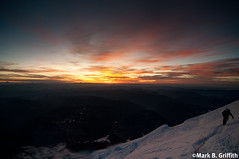 None of us felt any altitude sickness, though as we'd climb higher we felt the effects of the altitude on our stamina and strength. Another aspect of climbing in the dark is coming upon features unaware. As we made our way up a steep slope we angled to the right paralleling the slope, a narrow ledge two boots wide cut across and suddenly the downward slope to right dropped off rather steeply, in the dark it was not clear how far down. And on left left around waist high was a knife edge of snow that I could rest my hand on. Over the this knife edge was an open crevasse. It was when I was in the middle of this ledge with the steep drop off below me and a crevasse on the other that the rope stopped moving ahead of me. When the rope stops you stop. By this time the wind had really started to blow and I had to hold onto the precarious snow ridge to keep from being blown off balance. There was no use yelling ahead to query Seth as he wouldn't be able to hear. In a few moments the roped moved ahead and I followed down and around the ledge to where I was adjacent to the crevasse and a snow bridge crossed. Here Seth had stopped to gain his bearings and to prepare to step across, always an pause worthy endeavor.
None of us felt any altitude sickness, though as we'd climb higher we felt the effects of the altitude on our stamina and strength. Another aspect of climbing in the dark is coming upon features unaware. As we made our way up a steep slope we angled to the right paralleling the slope, a narrow ledge two boots wide cut across and suddenly the downward slope to right dropped off rather steeply, in the dark it was not clear how far down. And on left left around waist high was a knife edge of snow that I could rest my hand on. Over the this knife edge was an open crevasse. It was when I was in the middle of this ledge with the steep drop off below me and a crevasse on the other that the rope stopped moving ahead of me. When the rope stops you stop. By this time the wind had really started to blow and I had to hold onto the precarious snow ridge to keep from being blown off balance. There was no use yelling ahead to query Seth as he wouldn't be able to hear. In a few moments the roped moved ahead and I followed down and around the ledge to where I was adjacent to the crevasse and a snow bridge crossed. Here Seth had stopped to gain his bearings and to prepare to step across, always an pause worthy endeavor. Slowly every so slowly as kept climbing upwards the sky began to have the tiniest bit of light. One of the most special things about climbing mountains is that you get to see the dawn from on high. Being able to see the sun come up with the world below you is a special thing few get to experience. The sunrise from Rainier was stunning, we paused for a brief moment to watch the fantastic sky and the sun break over the horizon. Then we turned and put our heads down and kept on climbing.
Slowly every so slowly as kept climbing upwards the sky began to have the tiniest bit of light. One of the most special things about climbing mountains is that you get to see the dawn from on high. Being able to see the sun come up with the world below you is a special thing few get to experience. The sunrise from Rainier was stunning, we paused for a brief moment to watch the fantastic sky and the sun break over the horizon. Then we turned and put our heads down and kept on climbing. 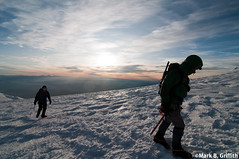 Eventually we approached 13000 feet and the ridge line appeared above us with open sky. In mountaineering and especially with Rainier typically no matter what you see and want to believe the ridge line above you is not the top, and when you arrive there is more mountain left to climb. Atop the ridge line was the Winthrop saddle, a large flat area between the Liberty Cap and the cinder cone with the caldera and Columbia Crest where the true summit lies. From here you have over a 1000 feet still to go and I was completely whupped. About 45 minutes earlier my water bladder had frozen and I was out of water. Dehydrated and feeling the effects of the elevation I very very slowly made my way up the saddle.
Eventually we approached 13000 feet and the ridge line appeared above us with open sky. In mountaineering and especially with Rainier typically no matter what you see and want to believe the ridge line above you is not the top, and when you arrive there is more mountain left to climb. Atop the ridge line was the Winthrop saddle, a large flat area between the Liberty Cap and the cinder cone with the caldera and Columbia Crest where the true summit lies. From here you have over a 1000 feet still to go and I was completely whupped. About 45 minutes earlier my water bladder had frozen and I was out of water. Dehydrated and feeling the effects of the elevation I very very slowly made my way up the saddle. 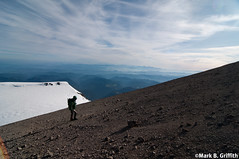 Here we dropped our rope and debated which route to the summit. We could ascend directly up the steep snow slope or we could make our way to the right and the southern slope of the code which was bare of snow and steeply lined with scree. There were several other groups making their way down the rocks and so we choose the later route. We slowly made our way to the rocks and sat down to take a break. . The temperature was around 28 degrees and the wind was blowing around 35-45 mpg. Luckily there was a fumarole which was venting hot steam and I quickly unthwawed my water, hydrated and we ate a bit of food.
Here we dropped our rope and debated which route to the summit. We could ascend directly up the steep snow slope or we could make our way to the right and the southern slope of the code which was bare of snow and steeply lined with scree. There were several other groups making their way down the rocks and so we choose the later route. We slowly made our way to the rocks and sat down to take a break. . The temperature was around 28 degrees and the wind was blowing around 35-45 mpg. Luckily there was a fumarole which was venting hot steam and I quickly unthwawed my water, hydrated and we ate a bit of food. 
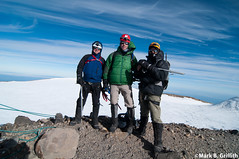

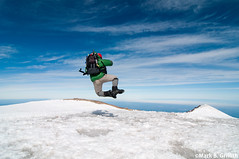
The last 800 feet up the scree was slow and tiring. Two steps forward one step back. At the top of the ridge we looked across to see the final dome of snow and ice that comprised the summit. We made our way over and walked the last few feet to the top where the wind whipped and howled. I was grateful for my Patagonia DAS parka and a balaclava to keep my face warm. Strangely from the snow dome an adjacent rocky ridge looked higher so we plodded over there to just be sure and posed there for photos as well. Then we dropped down over the ridge into the caldera to sit for a bit and take a break. It felt good to rest, but honestly your so tired from the climb and the altitude and you know in the back of your head you've got to start down soon before the snow gets too soft that you really can't enjoy the summit for too long. I remember feeling a genuine sense of wonder at the accomplishment of what we'd done. A year in the planning, training and anticipating and now we'd done it. 8 hours after starting we'd finally reached the highest point.
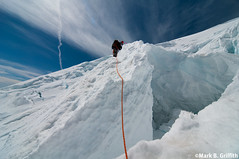 We made our way back around the ridge to the scree slope. Sliding down on our boot heels was so much more enjoyable than are ascent. We picked our gear back up and roped up and headed back over the Winthrop Saddle and down the slope. Going down isn't as hard as going up, but its by no means easy. The soft snow gives way at every step, sliding and slushing you slip down the mountain trying to not fall over. This is hard on the leg muscles. You wish you could glissade but sliding into a crevasse is not necessarily a faster way down the mountain. We quickly came upon the narrow ridge, crevasse and snow bridge we'd crossed early in the dark. In the light of day it wasn't nearly as spooky. We placed a picket at the top in a running belay to offer a bit of protection as we made our way across and around and down.
We made our way back around the ridge to the scree slope. Sliding down on our boot heels was so much more enjoyable than are ascent. We picked our gear back up and roped up and headed back over the Winthrop Saddle and down the slope. Going down isn't as hard as going up, but its by no means easy. The soft snow gives way at every step, sliding and slushing you slip down the mountain trying to not fall over. This is hard on the leg muscles. You wish you could glissade but sliding into a crevasse is not necessarily a faster way down the mountain. We quickly came upon the narrow ridge, crevasse and snow bridge we'd crossed early in the dark. In the light of day it wasn't nearly as spooky. We placed a picket at the top in a running belay to offer a bit of protection as we made our way across and around and down.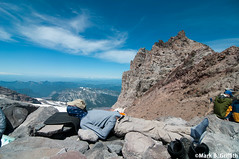 Finally around noon we stumble into camp and drop our packs, harnesses and ropes on the rocks. Kicking off our harnesses we all grabbed a pad and lay down for a quick nap. Within seconds I was sound asleep on my pad out in the sun on the heli-pad. We dozed for around 45 minutes until I woke with a snort. I filled water bottles and we spent the next 2 hours breaking down camp and stuffing everything back in our packs. While packing we overheard a gentleman talking about his scramble up on Steamboat Prow. We'd seen a ranger depart the day before up over the ridge. We decided to take this route up and over to the Inter Glacier so that we didn't have to put the rope and harness back on and downclimb across the Emmons Glacier.
Finally around noon we stumble into camp and drop our packs, harnesses and ropes on the rocks. Kicking off our harnesses we all grabbed a pad and lay down for a quick nap. Within seconds I was sound asleep on my pad out in the sun on the heli-pad. We dozed for around 45 minutes until I woke with a snort. I filled water bottles and we spent the next 2 hours breaking down camp and stuffing everything back in our packs. While packing we overheard a gentleman talking about his scramble up on Steamboat Prow. We'd seen a ranger depart the day before up over the ridge. We decided to take this route up and over to the Inter Glacier so that we didn't have to put the rope and harness back on and downclimb across the Emmons Glacier.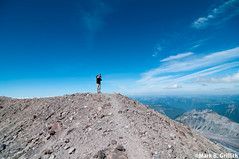 We departed at 3pm, wearing our helmets and ball caps to ward off the sun and any rock fall. We made our way past the bathroom and each waited in turn for the other to ascend the gully. The climb up out over the prow was the most freaked I was on the entire climb. Steamboat Prow is a choss heap, an amalgam of dirt, gravel and crumbling lava-esque rock. The holds were all solid and it wouldn't normally have concerned me in the slightest but I had a 50 lb pack on and with my helmet and a baseball hat I had a hard time as I scrambled up being able to tilt my neck back far enough to see the route ahead. Eventually I made it to the top and stopped to hang on and relax. Dean made his way last up the slope. He was none to happy with the sketchy nature of the climb.
We departed at 3pm, wearing our helmets and ball caps to ward off the sun and any rock fall. We made our way past the bathroom and each waited in turn for the other to ascend the gully. The climb up out over the prow was the most freaked I was on the entire climb. Steamboat Prow is a choss heap, an amalgam of dirt, gravel and crumbling lava-esque rock. The holds were all solid and it wouldn't normally have concerned me in the slightest but I had a 50 lb pack on and with my helmet and a baseball hat I had a hard time as I scrambled up being able to tilt my neck back far enough to see the route ahead. Eventually I made it to the top and stopped to hang on and relax. Dean made his way last up the slope. He was none to happy with the sketchy nature of the climb. 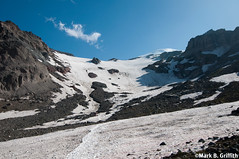 But as we topped out over the Prow though the Inter Glacier stretched out before us the promise of a 3000 ft glissade quickly made us forget. Dean made Seth go first to make up for going up over rock pile. I followed him and was able to get 2800 feet in a single track! We then had to walk over 50 feet or so and jump on an old track to make our way down to the very bottom. What had taken 3 hours 2 days before to go up took less than 10 minutes to go down. That has to be the best glissade in the entire state of Washington.
But as we topped out over the Prow though the Inter Glacier stretched out before us the promise of a 3000 ft glissade quickly made us forget. Dean made Seth go first to make up for going up over rock pile. I followed him and was able to get 2800 feet in a single track! We then had to walk over 50 feet or so and jump on an old track to make our way down to the very bottom. What had taken 3 hours 2 days before to go up took less than 10 minutes to go down. That has to be the best glissade in the entire state of Washington.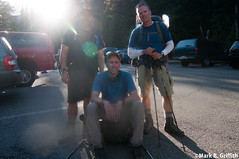 We dropped our glacier gear and reloaded the packs and set off down the moraine through Glacier Basin and down the trail adjacent to the White River. It was 5pm and we were tired and hungry. We wanted some real food and so we set a killer pace down the trail. We passed everyone we saw motoring our way down the trail. My feet were killing me from the pounding and as Dean said those last 3 miles felt like 20. Finally after falling once in the creek from a slip on the rock we reached the car. Dropping our packs we posed for one last final "after photo" and then I grabbed a fresh change of clothes and made my way to the camp faucet near the bathroom to "shower" and change.
We dropped our glacier gear and reloaded the packs and set off down the moraine through Glacier Basin and down the trail adjacent to the White River. It was 5pm and we were tired and hungry. We wanted some real food and so we set a killer pace down the trail. We passed everyone we saw motoring our way down the trail. My feet were killing me from the pounding and as Dean said those last 3 miles felt like 20. Finally after falling once in the creek from a slip on the rock we reached the car. Dropping our packs we posed for one last final "after photo" and then I grabbed a fresh change of clothes and made my way to the camp faucet near the bathroom to "shower" and change.We hopped in the car, cranked the tunes on the I-pod and made our way to that fresh smelling corner of the cow pie Enumclaw where we stopped at the Rainer Bar and Grill for a steak and potato feed. Piling back in the car I fought sleep as I dropped of first Dean and then Seth. I rolled into my driveway around 10:30, 24 hours after I'd woken the night before and miles and miles. But when my head hit the pillow, I was satisfied, and I slept like a log.
Flickr Photos
| Set on www.flickr.com |
VIDEO
Climbing Rainier from mbgriffi on Vimeo.
(Route route : http://tinyurl.com/schurman)

2 Comments:
Nice writeup, Mark. Re route: when watching the video before, I'd wondered about the route to the summit--I was shocked to think that the snow/ice we'd been up only a couple of weeks before was melted out, but I see you didn't go up the same way from the saddle at Liberty Cap.
And yes, isn't that glissade sweet? Best ever, indeed.
Congrats on achieving your goal! I bet it's nice to be able to look out at 'the mountain' and know that you've been to the top.
This was fascinating to read. You would definitely have to trust your climbing partners (and yourself). You must be so proud of reaching your goal.
Post a Comment
<< Home